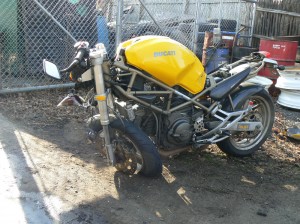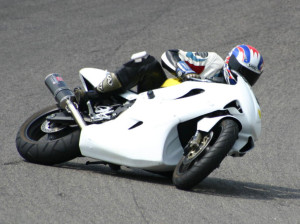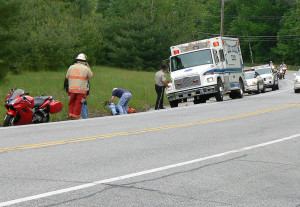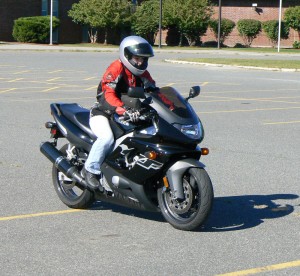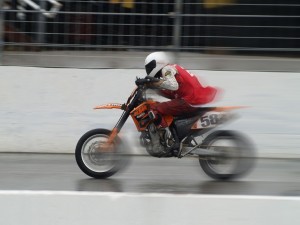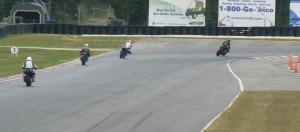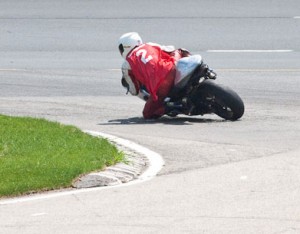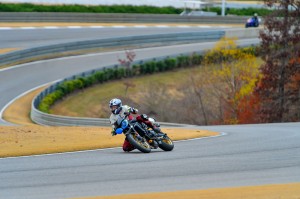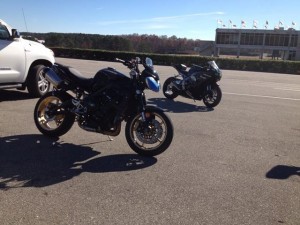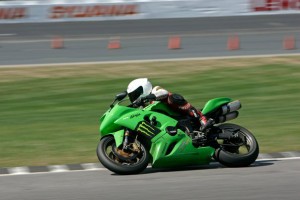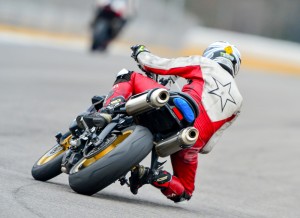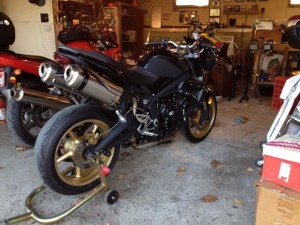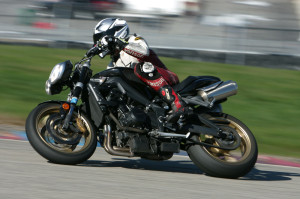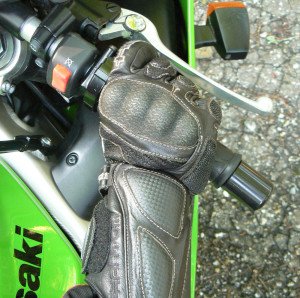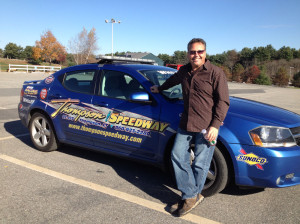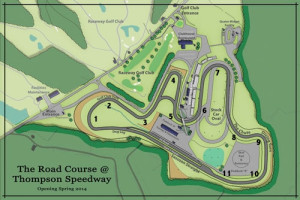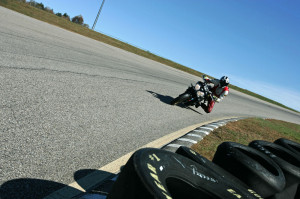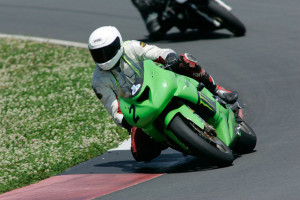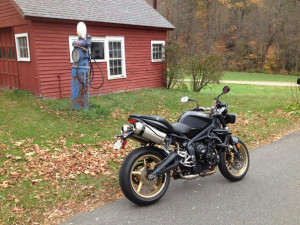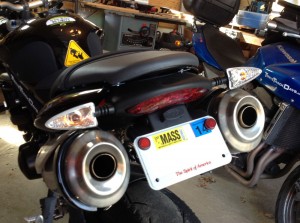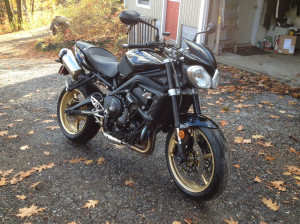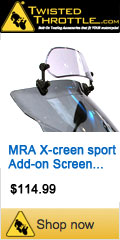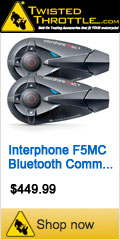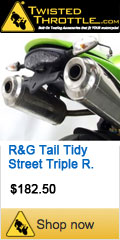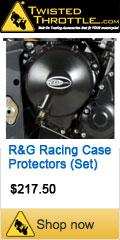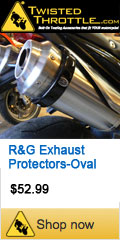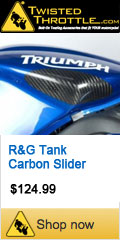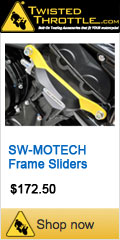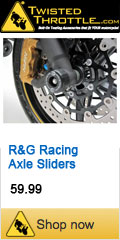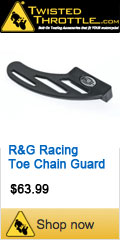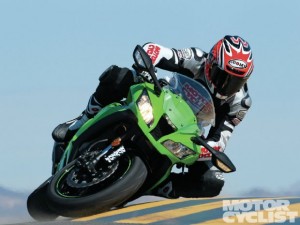
Is it possible to not crash when you experience a front tire slide? Maybe.
Both of my recent track crashes were the result of a sliding front tire (both were caused by me asking too much of a cold front tire). Sometimes it happens too quickly for you to respond. But, sometimes there is enough time to perform a maneuver that just may save you from a fall.
Survival Instincts Are a Bitch
Let’s say you are rounding a curve and the handlebar starts to feel vague in your hands. At the same time, your proprioceptors (aka kinesthetic sense) tell your brain that balance is being compromised.
Your brain is alerted to the threat and triggers your muscles to tense. The rush of panic and muscle tension happens in an instant. Many riders end up on the ground because their survival instincts cause them to overreact and make matters worse.
Saving the Front in a Corner
I’ve got bad news for you, that vagueness you feel at the handlebars is your front tire losing traction. This is bad, because a front tire slide is one of the most difficult situations to recover from. When cornering, the front tire is responsible for both lateral grip and direction control (steering). More times than not, front tire traction loss is the result of asking too much of the tire. Side forces from cornering, in combination with cold rubber and perhaps contaminated pavement is an easy recipe for tire slip.
When the front tire loses grip, it “tucks” underneath the bike and throws the bike and rider violently to the ground. But, is it possible to save yourself from falling?
To help the front tire regain traction (or at least not lose any more grip) you must first not add to the problem. This means staying relaxed (Good luck with that). With light handlebar pressure, the tire and suspension can work fluidly to manage surface irregularities.
If you tense on the bars, you will put stress on the front tire and risk pushing the tire over the limit of grip. Whatever you do, avoid trying to countersteer the bike into a deeper lean.
Assuming you can remain somewhat relaxed and neutral, the next thing to do is to relieve the work the front tire is doing. To do this, get on the throttle! I know, it’s counter-intuitive, which is why it’s not easy to do. But gassing it transfers load from the overworked front tire to the rear tire.This allows the front rubber to halt its lateral slide and keep rolling.
Yes, you will probably run wide, but hopefully you have enough road/track to let this happen. You can minimize this drift by using moderate throttle application to save the front tire slide. Just don’t goose the throttle so hard that you careen off the road or track or spin the rear tire.
Uphill Unload
A fellow instructor pointed out a caveat to the common cornering situation. Dan mentioned what can happen to traction when you are going uphill. He witnessed a fellow rider (with a passenger) lose the front and crash in front of him just as the crashing rider was getting on the gas. Why would this happen if what I say about relieving stress on the front tire is true?
The likely explanation is that the uphill slope, in combination with the weight of a passenger and the application of a bit too much throttle, unloaded the front tire too much. He probably also added a bit of steering input that tucked the front tire beneath him. The lesson is that load management and traction management go hand in hand and you need to develop a keen sense of how various factors can affect tire load and grip.
The Knee Save
For those who are accustomed to dragging knee, it is possible to relieve front tire stress by levering the bike with your knee. Anything you can do to take pressure off the front tire will help the tire regain grip.
Saving the Front While Braking
The other way to experience a front tire induced crash is to overbrake so you skid the front tire. This can happen whether you are upright or leaned. If this happens, get off the brake, NOW! This will let the front wheel roll again so you can regain control. Then get back on the brakes (you were braking for a reason, right?). But, this time squeeze the front brake progressively. You can still brake really hard (less so if you are leaned), but it must be done gradually to allow time to put load on the front tire, which increases traction.
Practice? Really?
It takes a good amount of skill and presence to control front tire skids. Like all other tricky situations, practice and experience increases the chance that you can act correctly and save a crash. Practice? How? Ride in the dirt, my friend! Pushing the front tire is a regular occurrence when riding on loose surfaces. Learning to control slides in the dirt is less risky than suddenly needing to manage a slide on your street bike. With this experience, you can train and condition your mind and muscles to react properly when a slide happens.
The other way to train yourself to react properly is to push your bike hard enough to get it to happen. I don’t recommend this, because front tire slides can easily go wrong. But, if you eventually go fast enough at track days or when racing, you will inevitably experience the vague feeling of your front tire on the edge of traction loss.
DO NOT go fast enough to slide the front on the street!! You will die. On the street, it’s not likely that you will have enough time or space to pull off this hero maneuver.
What? You don’t ride on the track or in the dirt? Well, the next best way to practice is to visualize successfully performing the maneuver. Imagine yourself cornering hard, feeling handlebar vagueness and then gradually rolling on the throttle as needed to drift the front. It’s not ideal, but it’s the best way to prepare for saving a front tire slide.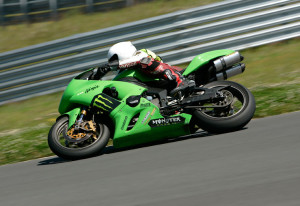
Expect It
Another way to prepare for front tire slides (and many others) is to expect them to happen. This pertains to all times when you are in traction-reduced situations, including when cornering or braking hard.
Have you experienced a front tire skid or slide? If so, how did that work out for you?
Please Donate to Keep the Articles Coming
If you liked this article and the many other articles on this site, please toss a buck or five into the hat. It’s greatly appreciated!
- Click the PayPal “Pay Now” button.
- Then indicate quantity in $2.00 increments. – Example: put “2” in “QUANTITY” field to donate $4.00, “3” for a $6.00 donation, etc.
Why $2.00? Due to the PayPal fee structure, a $2.00 donation is significantly more beneficial compared to a $1.00 donation.
Thank You!
Check out these posts:
- Product Review: TCX X-Desert Boots
- Get Anxiety & Stress Under Control (Motorcyclist)
- KLX250s Upgraded and Accessorized
- Street Triple R Gets Accessorized
- Triumph Street Triple R Review
- How To Survive Mid-Corner Hazards
- #1 Reason for Motorcycle Crashes in Corners
How Can I help You? Online Coaching NOW AVAILABLE
Stay Informed: Subscribe NOW!
 Be a Better Rider: Sign Up for Personal Training with Ken
Be a Better Rider: Sign Up for Personal Training with Ken
Support Riding in the Zone: Buy a book
Support Riding in the Zone: Buy products from Twisted Throttle & Amazon









